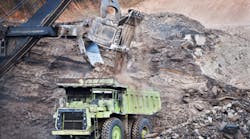The number of mining fatalities in 2017 already is outpacing last year’s count as of the end of July, according to MSHA.
Three separate accidents at different worksites bring the total number to 10 deaths this year, with metal and nonmetal and machinery incidents combined. MSHA released the details of the three fatalities as “fatalgrams,” which provide a brief description as well as best practices for preventing similar occurrences.
The first incident, which happened on July 14, involved a part-time mine employee who was moving irrigation pipe by hand. The worker was electrocuted when the pipe came in contact with high voltage transmission lines overhead. MSHA provided the following guidelines for similar circumstances:
- Before work begins, conduct a hazard assessment and examine the work area to identify and correct hazards and ensure safe distances to overhead power lines.
- Contact the electrical utility to determine the operating voltage of the line and confirm the safe limits of approach distances.
- Do not use electrically conductive tools or materials in situations where they may contact overhead power lines.
According to the agency, this was the fifth fatality of 2017 in the metal and nonmetal mining segment.
Another accident occurred on July 20 as a miner was driving wedges into a block of granite in an attempt to break it loose. During the process, a 9-ton piece of granite fell and crushed the victim. MSHA provided the following best practices:
- Always conduct examinations of work place to identify loose ground or unstable conditions before work begins and as changing ground conditions warrant.
- Ensure that the person conducting the examination has the training and experience to recognize potential hazards.
- Danger off hazardous conditions and prohibit work or travel in areas where hazards from unstable ground have not been corrected.
- Discuss work procedures and identify all hazards associated with the work to be performed along with the methods to protect personnel.
The fatality marked the sixth in the metal and nonmetal mining segment for 2017. As of the same date in the previous year, there were 9 fatalities reported in metal and nonmetal mining.
On July 25, a bulldozer ran over a worker who had a reported seven years of mining experience. Employees discovered the victim lying in the bulldozer’s push path. According to the agency, the bulldozer had run over the victim and continued over the edge of an incline, coming to rest at the bottom of an embankment. MSHA recommended the following best practices:
- Ensure that persons are trained, including task-training, to understand the hazards associated with the work being performed.
- Maintain control of mobile equipment while it is in motion.
- Maintain equipment braking systems in good repair and adjustment. Conduct proper maintenance on safety related systems.
- Before leaving a bulldozer unattended, operators should follow manufacturer-recommended operating procedures to ensure that the equipment is secured from movement. This could include disengaging the transmission, setting the parking brake, and lowering the bulldozer blade to the ground before dismounting the equipment.
- Do not depend on hydraulic systems to hold mobile equipment stationary.
- Establish and discuss safe work procedures before beginning work. Identify and control all hazards associated with the work to be performed and use methods to properly protect persons.
- Do not place yourself in a position that will expose you to hazards while performing a task.
According to the agency, this was the second machinery fatality for the year, bringing the total number of coal mining deaths as of the end of July to 10 in 2017, compared to six at the same time last year.
